New York State Assembly
March 1997
|

Shedding Light On New York's Surging Electricity
Prices
A Briefing Paper on Moving to Competition in the
Electric Industry
Sheldon Silver
Speaker of the Assembly
Michael J. Bragman
Majority Leader of the Assembly
Paul D. Tonko, Chair
Assembly Standing Committee on Energy
|
Dear Reader,
This document is our second in a series of briefing
papers, providing background and focus for the public policy decisions
which must be made during the transition to competition in the electric
industry in New York and in the nation.
It is clear from the price information contained in
this paper that the costs to New Yorkers are unacceptably high. These costs
are real. The effects of high electricity prices include tens of thousands
of lost jobs and a financial burden to every New York family. The gap between
New York’s electricity prices, regulated by the Public Service Commission,
and the national average electric price continues to widen. Our competitive
disadvantage is enormous and growing.
Only a comprehensive statewide solution that reforms
an antiquated regulatory framework will move New York successfully to competition
and will significantly reduce electric rates toward national levels. Without
a statutorily established comprehensive framework for competition in the
electric industry, New York’s consumers face additional risks, including
the loss of service quality and electric system reliability.
Additional publications on energy, including a detailed
description of Competition Plus/ Energy 2000, the only comprehensive New
York governmental proposal to address the move to competition, are available
from the Assembly Press Office, by calling (518) 455-3888. The Internet
location (www.assembly.state.ny.us.) also makes these papers available.
A list of papers is included at the end of this report.
|
Shedding Light on New York State's
Surging Electricity Prices
New Yorkers pay excessive electric prices using any measure of comparison.
Electric utilities in New York, on average, charge more per unit of electricity
than utilities anywhere else in the nation. The consequences are real and
damaging to New York residents and businesses. Tens of thousands of jobs
have been lost as a direct result of these disproportionately high electric
prices. The situation is becoming more critical with each passing year.
New York State's Surging Electricity Prices . . .
- New York State’s electric utilities sell the most expensive electricity
in the United States.
- The average price for electricity produced by New York State’s utilities
was 72 percent higher than the national average in 1995. Even when including
lower-priced electricity produced by the Power Au- thority of the State
of New York (PASNY), the average price still was 61 percent above the national
average.
- From 1980 to 1995, the premium paid by New Yorkers due to higher-than-average
electric prices increased by over 100 percent.
- Between 1987 and 1995, New York’s electric prices increased by 26 percent,
while national energy prices remained stable.
|
- New York State’s average electric prices continue to increase relative
to the nation, other regions, and other competing states.
- In 1995, New Yorkers paid $14.4 billion in electricity costs, including
$5.5 billion paid by residential customers, $6.3 billion paid by commercial
customers, and $1.5 billion paid by industrial customers.
- In 1995, New Yorkers paid $5.4 billion more in electricity costs than
they would have paid if New York State's average elec- tric price had been
on a par with the nation's average price. This extra payment is the equivalent
of a “tax” on every family and business in New York State.
|
New York State Versus the Nation
Beginning with the energy crisis of 1973, New York’s average price for
electricity rose an unprecedented 270 percent through 1995. Since 1990,
it grew 18 percent.
The gap between the State’s electricity prices and national prices more
than doubled between 1980 and 1995. Between 1987 and 1995, national electricity
prices were relatively flat, while New York prices grew by approximately
26 percent. Between 1991 and 1995, the nation's average electric price
rose 2.8 percent, while New York's rose 13.3 percent. By 1995, the average
price for electricity in the nation had been declining for two years, while
New Yorkers were paying for a 3.7 percent increase in electric prices.
Figure 1
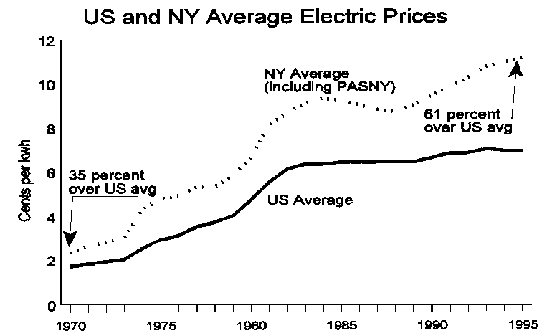
Source: Energy Information Administration.
New York ratepayers now pay on average an astonishing 61 percent more
than the rest of the country, and the difference is even larger if low-cost
electricity from the Power Authority of the State of New York (PASNY) is
taken out of the calculation.
Some customers in New York receive lower-cost power from PASNY. PASNY’s
low-cost hydroelectric plants represent 9 percent of New York’s total electric
generating capacity. The lower-priced PASNY power, which is not available
to most New York utility customers, reduces the overall average of New
York's electricity prices to a level somewhat lower than the average price
charged by New York’s electric utilities. This difference skews price comparisons
between New York and other states that do not have access to public power.
The effect of PASNY power on New York State prices is discussed more fully
in the Appendix at the back of this report.
Figure 2

Source: NYS Energy Research and Development
Authority.
New York State and Other Regions
New York State’s sharper electric price rise has resulted in a widening
of the gap between the State’s electric price and that of its neighbors.
In 1992, New York State's average electric price was 1.2 cents/ kilowatt-hour
(¢/kwh) or 13.3 percent over the Northeast average, excluding New
York State. Three years later, the State's electric price stood at 1.8
¢/kwh or 19.4 percent over the Northeast average, excluding New York
State.
Figure 3
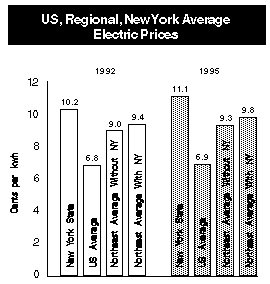
Source: US Energy Information Administration.
Note: New York average includes PASNY power.
Northeast includes CT, ME, MA, NH, NJ, NY, PA, RI, VT.
As Figure 3 shows, the nation’s average electricity price rose by 0.1
¢/kwh or 1.5 percent from 1992 to 1995. The average electricity price
for Northeast states, other than New York, increased by 3.3 percent between
1992 and 1995. In contrast, New York State's average price for electricity,
including the lower-cost power from PASNY, rose by 0.9 ¢/kwh or 8.8
percent between 1992 and 1995.
Table 1 below lists the average electric price in various regions of
the United States.
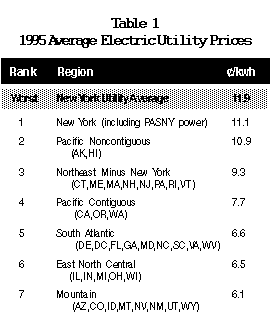
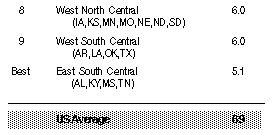
Source: US Energy Information Administration.
Competing States
Higher electric prices put New York’s businesses at a significant competitive
disadvantage. The retention and creation of jobs within New York State
is made more difficult by the higher electric prices that New York businesses
face. Many of the states depicted in Figures 4 and 5 are states which offer
New York businesses a competitive option or are states which have actively
attempted to reduce their electricity costs.
|
Figure 4
Source: US Energy Information Administration.
|
Figure 5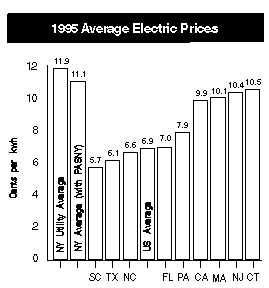
Source: US Energy Informatin Administration.
|
Between 1992 and 1995, the average electric price in New York State
increased by 8.8 percent from 10.2 ¢/kwh to 11.1 ¢/kwh, while
the average electric price fell in Pennsylvania and Texas by 0.1 ¢/kwh.
Florida's and North Carolina’s electric prices remained stable. New Jersey's
electric price rose by 0.9 ¢/kwh. Average electric prices in Massachusetts,
Connecticut, and California rose by smaller amounts, 0.4 ¢/kwh, 0.5
¢/kwh, and 0.2 ¢/kwh, respectively.
In both 1995 and 1992, South Carolina, Texas and North Carolina had
average electric prices below the national average, and Florida, Pennsylvania,
California, Massachusetts, New Jersey, and Connecticut had average electric
prices above the national average.
Table 2 lists the average electric price in each State and in the District
of Columbia.
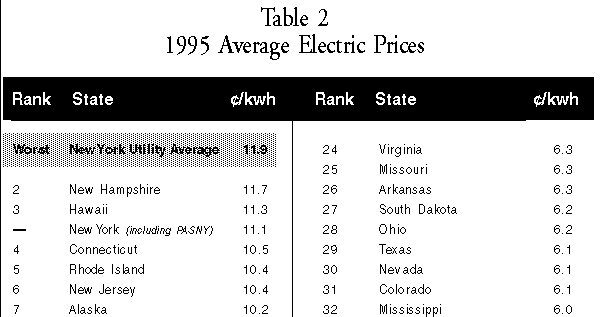


Source: US Energy Information Administration.
Appendix
PASNY Power Makes New York's Prices Look Better
Because it operates the Niagara and St. Lawrence hydroelectric projects,
PASNY generates some of the least expensive power in the nation. However,
according to federal and State law, only some businesses and certain other
institutional and residential customers may buy PASNY power. Other customers
must rely primarily on local utilities for power. Therefore, to get a true
idea of the State’s average electric price based upon generally available
electric power as compared to that of competing states, one would need
to consider two New York State average electric prices, one price adjusted
for PASNY power and one unadjusted. As discussed here, the price that is
not adjusted for PASNY is called the electric utility average, and the
price that is adjusted for PASNY is referred to as the PASNY-adjusted average
electric price.
Figure 6
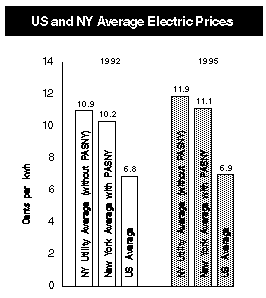
Source: Department of Public Service, Energy
Inforamtion Administration.
The average price of electricity in the nation rose only 1.5 percent
from 6.8 to 6.9 ¢/kwh between 1992 and 1995, while the New York electric
utility average rose from 10.9 to 11.9 ¢/kwh, an increase of 9.2 percent.
The PASNY-adjusted average electric price rose 8.8 percent from 10.2 to
11.1 ¢/kwh.
In both years, the State’s electric utility average was about 7 percent
higher than the PASNY-adjusted average electric price.
The electric utility average in the State was 60 percent higher than
the national average in 1992 and 72 percent higher in 1995. The State’s
PASNY-adjusted average electric price exceeded the national average by
50 percent in 1992 and by 61 percent in 1995.










